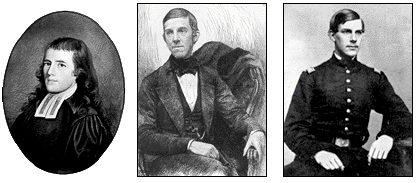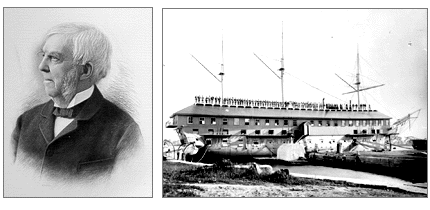|
"Old Ironsides"
by
Oliver
Wendell Holmes
September 16, 1830
Ay, tear her tattered ensign down!
Long has it waved on high,
And many an eye has danced to see
That
banner in the sky;
Beneath it rung the battle shout,
And burst the cannon's roar;
The meteor of the ocean air
Shall
sweep the clouds no more.
Her deck, once red with heroes' blood,
Where knelt the vanquished foe,
When winds were hurrying o'er
the flood,
And waves were white below,
No more shall feel the victor's tread,
Or know the conquered knee;
The
harpies of the shore shall pluck
The eagle of the sea!
Oh, better that her shattered bulk
Should sink beneath the wave;
Her thunders shook the mighty deep,
And
there should be her grave;
Nail to the mast her holy flag,
Set every threadbare sail,
And give her to the god of
storms,
The lightning and the gale!
A SPECIAL THANKS To Seacoast New Hampshire / www.SeacoastNH.comFor The Following Information & Pictures Copyright © 1998-2000
A SPECIAL THANKS
To
Seacoast New Hampshire / www.SeacoastNH.com
For The Following Information & Pictures
Copyright
© 1998-2000
AUTHOR'S NOTE
By Oliver Wendell Holmes
This was the popular name by which the frigate Constitution was known. The poem was first printed
in the Boston Daily Advertiser, at the time when it was proposed to break up the old ship as unfit for service. I subjoin
the paragraph which led to the writing of the poem. It is from the Advertiser of Tuesday, September 14, 1830:--
"Old Ironsides.--- It has been affirmed upon good authority that the Secretary of the Navy has
recommended to the Board of Navy Commissioners to dispose of the frigate Constitution. Since it has been understood that such
a step was in contemplation we have heard but one opinion expressed, and that in decided disapprobation of the measure. Such
a national object of interest, so endeared to our national pride as Old Ironsides is, should never by any act of our government
cease to belong to the Navy, so long as our country is to be found upon the map of nations. In England it was lately determined
by the Admiralty to cut the Victory, a one-hundred gun ship (which it will be recollected bore the flag of Lord Nelson at
the battle of Trafalgar), down to a seventy-four, but so loud were the lamentations of the people upon the proposed measure
that the intention was abandoned. We confidently anticipate that the Secretary of the Navy will in like manner consult the
general wish in regard to the Constitution, and either let her remain in ordinary or rebuild her whenever the public service
may require."--New York Journal of Commerce.
YOUNG HOLMES

The minister, the doctor and the lawyer, all in their early years. Rev. Abiel Holmes (left)
was the poet's father who may have been the inspiration for the poem "Old Ironsides." A youthful Oliver Wendell Holmes (center)
as a law student about the time he wrote the famous poem at age 21 in one quick inspirational session in 1830. His son Oliver
Wendell Holmes, Jr. during the Civil War, about the time of his romance with Dover, NH's Lucy Hale, and before his esteemed
career as a Supreme Court Justice.
Abiel Holmes and early OWH pictures from The Life and Letters of Oliver Wendell Holmes, 1896. OWH Jr.
photo appears in various sources.
OLD HOLMES, OLD IRONSIDES

Oliver Wendell Holmes died in 1894 at age 85. When he "passed to the other shore" on October
7, the USS Constitution was still afloat and being used as a receiving ship at the Portsmouth Naval Shipyard. The photo above
shows a veteran's group during a gala party held aboard "Old Ironsides" in 1891, before it was towed to its permanent home
in Boston in 1997.
Holmes photo from Life and Letters of Oliver Wendell Holmes, 1895. Ironsides photo from US Navy, Patch
Collection, Portsmouth Athenaeum.
|

